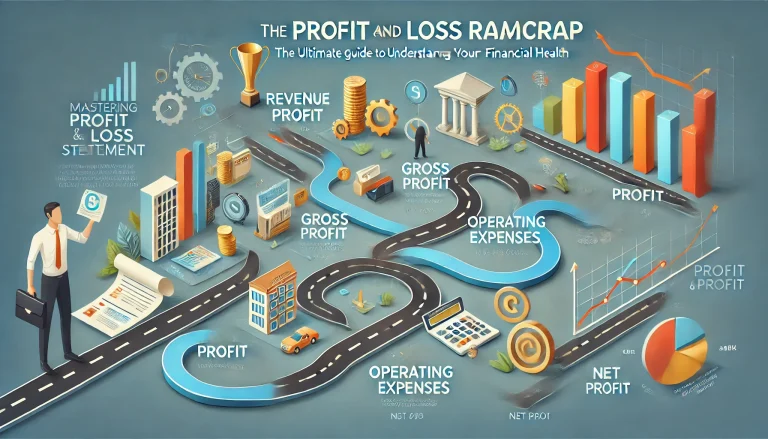Financial trends are the lifeblood of informed business decisions, revealing the subtle pulses that dictate market movements and corporate health. “How to Interpret and Use Financial Trend Analysis” isn’t just a guide—it’s your gateway to understanding the hidden narratives within financial data, enabling you to make decisions that propel your business forward.
Disclosure: If you click on my affiliate/advertiser’s links, I am going to receive a tiny commission. AND… Most of the time, you will receive an offer of some kind. It’ s a Win/Win!
In today’s fast-paced world of economy, standing still means falling behind. The ability to interpret and leverage financial trend analysis is what separates thriving enterprises from those that merely survive. This skill not only sharpens your financial acumen but also enhances your strategic foresight, positioning you as a leader in your industry.
Imagine having the capability to predict market shifts, understand the cyclical nature of your industry, and make data-driven decisions with confidence. By mastering financial trend analysis, you unlock these capabilities, transforming raw data into actionable insights.
This article will walk you through the essential steps of financial trend analysis, from the foundational concepts to advanced techniques. You’ll discover how to read financial statements, identify key trends, and use this knowledge to improve your business strategy. Whether you’re a seasoned executive or an emerging entrepreneur, these insights are crucial for elevating your business acumen.
Stay with us as we look into the intricacies of financial trend analysis. By the end of this article, you’ll be equipped with the tools and knowledge to interpret financial data effectively and apply it to drive business success.
Elements you need to understand:
1. **Understanding Financial Trend Analysis**
– This section covers the basics of financial trend analysis, explaining what it is and why it is essential for businesses.
2. **Key Financial Statements to Analyse**
– Learn about the crucial financial statements you need to examine, including income statements, balance sheets, and cash flow statements.
3. **Identifying Significant Trends in Financial Data**
– Discover how to spot key trends within financial data that indicate the health and trajectory of a business.
4. **Utilising Financial Ratios for Trend Analysis**
– Understand how financial ratios can provide deeper insights into financial trends and business performance.
5. **Analysing Revenue and Expense Patterns**
– This section explores methods for examining revenue and expense trends to identify growth opportunities and cost-saving measures.
6. **Evaluating Industry and Market Trends**
– Learn how to incorporate industry and market trends into your financial analysis for a broader perspective.
7. **Predicting Future Financial Performance**
– Techniques for forecasting future financial performance based on historical trend analysis.
8. **Implementing Trend Analysis in Strategic Planning**
– How to integrate financial trend analysis into your strategic planning process to make informed business decisions.
9. **Common Pitfalls in Financial Trend Analysis**
– Identify and avoid common mistakes that can mislead your financial analysis and decision-making.
10. **Case Studies: Successful Use of Financial Trend Analysis**
– Real-world examples of businesses that have effectively used financial trend analysis to drive success.
11. Summary and Conclusion: Mastering Financial Trend Analysis for Business Success
By integrating these elements into your understanding of financial trend analysis, you’ll be prepared to elevate your business strategy and leadership skills, positioning your enterprise for sustained growth and success.
Understanding Financial Trend Analysis
Financial trend analysis is a cornerstone of effective business finance. It involves examining financial statements over a set period to identify patterns and trends that inform business decisions. By understanding these trends, businesses can predict future performance, make informed strategic decisions, and stay ahead of market changes. For instance, recognising a consistent increase in revenue over several quarters could signal a healthy growth trajectory, prompting further investment in expansion efforts.
Misinterpreting or overlooking financial trends can lead to misguided strategies. For example, a company might miss early warning signs of declining profitability, leading to financial instability. Therefore, mastering financial trend analysis is crucial for maintaining a robust financial health and ensuring long-term success.
Key Financial Statements to Analyse
To effectively perform financial trend analysis, it is vital to scrutinise key financial statements, including the income statement, balance sheet, and cash flow statement. The income statement reveals a company’s profitability over time, highlighting revenue, expenses, and net income. The balance sheet provides a snapshot of assets, liabilities, and shareholders’ equity at a specific point in time, helping to assess financial stability. The cash flow statement shows how cash is generated and used during a period, offering insights into liquidity and cash management.
For example, a consistent increase in accounts receivable on the balance sheet could indicate growing sales but might also suggest issues with cash collection. By regularly analysing these financial statements, businesses can gain a comprehensive understanding of their financial performance and make data-driven decisions.
Identifying Significant Trends in Financial Data
Spotting significant trends in financial data is essential for predicting future business performance. Trends such as revenue growth, cost fluctuations, and profit margins provide valuable insights into a company’s operational efficiency and market position. For instance, a trend of increasing gross margins suggests improved cost management or higher pricing power, both of which are positive indicators for investors.
Failure to identify these trends can result in missed opportunities or undetected risks. For example, if a business does not recognise a downward trend in its gross margin, it might not investigate underlying issues such as rising production costs or increased competition, which could ultimately harm profitability.
Utilising Financial Ratios for Trend Analysis
Financial ratios are powerful tools for interpreting financial trends. Ratios like the current ratio, debt-to-equity ratio, and return on equity provide a deeper understanding of a company’s financial health. For example, the current ratio, which compares current assets to current liabilities, indicates liquidity and the ability to meet short-term obligations. A rising current ratio over time suggests improving liquidity, while a declining ratio might signal potential liquidity issues.
Using these ratios, businesses can benchmark their performance against industry standards and identify areas for improvement. However, relying solely on ratios without considering the broader financial context can lead to misleading conclusions. Therefore, ratios should be used as part of a comprehensive financial analysis strategy.
Analysing Revenue and Expense Patterns
Examining revenue and expense patterns is crucial for identifying growth opportunities and cost-saving measures. Consistent revenue growth indicates a strong market position and effective sales strategies, while identifying areas of high expense can highlight potential cost-saving opportunities. For example, if a business notices a recurring spike in marketing expenses without a corresponding increase in sales, it might need to reassess its marketing strategies.
Ignoring these patterns can lead to financial inefficiencies. For instance, failing to identify and address escalating operational costs can erode profit margins over time. Therefore, regularly reviewing revenue and expense trends is essential for maintaining financial health and maximising profitability.
Evaluating Industry and Market Trends
Incorporating industry and market trends into financial trend analysis provides a broader perspective on a company’s performance. Understanding market dynamics, such as consumer behaviour shifts or technological advancements, helps businesses adapt their strategies accordingly. For example, a tech company might leverage industry trends showing increased demand for cybersecurity solutions to invest in relevant product development.
Neglecting to consider these external factors can result in strategic misalignment. A business might continue investing in declining market segments, missing out on emerging opportunities. Thus, staying informed about industry and market trends is crucial for making well-rounded, strategic business decisions.
Predicting Future Financial Performance
Forecasting future financial performance based on historical trend analysis is a critical skill for strategic planning. By identifying patterns in past financial data, businesses can project future revenues, expenses, and profitability. For instance, a retailer might use historical sales data to predict peak shopping periods and optimise inventory accordingly.
Inaccurate forecasting can lead to poor resource allocation and missed business opportunities. Overestimating future revenues might result in overexpansion, while underestimating them could mean missed growth opportunities. Therefore, accurate financial forecasting is essential for sustainable business growth.
Implementing Trend Analysis in Strategic Planning
Integrating financial trend analysis into strategic planning enables businesses to make informed decisions that align with their long-term goals. By understanding past performance and predicting future trends, companies can develop strategies that capitalise on strengths and address weaknesses. For example, a business noticing a steady increase in online sales might prioritise e-commerce development in its strategic plan.
Without incorporating trend analysis, strategic planning becomes a shot in the dark, increasing the risk of misguided initiatives. By grounding their plans in robust financial analysis, businesses can enhance their strategic direction and achieve sustainable growth.
Common Pitfalls in Financial Trend Analysis
Understanding and avoiding common pitfalls in financial trend analysis is essential for accurate decision-making. Common mistakes include over-reliance on short-term data, ignoring qualitative factors, and misinterpreting correlation as causation. For example, attributing a sales decline solely to market conditions without considering internal factors like product quality can lead to incorrect conclusions.
Addressing these pitfalls involves using comprehensive data sets, considering both quantitative and qualitative factors, and applying critical thinking to data interpretation. By doing so, businesses can improve the accuracy of their financial analyses and make better-informed decisions.
Case Studies: Successful Use of Financial Trend Analysis
Real-world examples of businesses that have successfully used financial trend analysis can provide valuable insights and inspiration. For instance, a company that identified a trend of increasing online engagement might have shifted its marketing focus to digital channels, resulting in significant revenue growth. Another business might have used trend analysis to identify declining product lines, allowing it to pivot and innovate successfully.
These case studies illustrate the practical benefits of financial trend analysis and highlight the importance of adapting strategies based on robust financial insights. By learning from these examples, businesses can apply similar techniques to their own operations, enhancing their strategic decision-making and overall success.
In conclusion, mastering financial trend analysis is essential for any business looking to elevate its financial acumen and strategic planning capabilities. By understanding and leveraging key financial trends, businesses can make data-driven decisions that drive growth, improve profitability, and secure a competitive edge in the market.
Summary and Conclusion: Mastering Financial Trend Analysis for Business Success
Financial trend analysis is more than a technical exercise—it’s a strategic tool that can transform how businesses understand and navigate their finances. Throughout this article, we’ve explored the critical components of financial trend analysis, from understanding its basics to utilising advanced techniques like financial ratios and revenue patterns. Each element plays a vital role in painting a comprehensive picture of your business’s financial health and future potential.
Analysing key financial statements, such as income statements, balance sheets, and cash flow statements, is fundamental for gaining insights into your company’s operations. By identifying significant trends in these documents, you can anticipate market shifts and make proactive decisions that enhance profitability and stability. Ignoring these trends can lead to financial missteps that are difficult to recover from.
The utilisation of financial ratios further deepens your understanding of financial trends. Ratios provide a benchmark for performance, helping you compare your business against industry standards and competitors. This comparative analysis is crucial for identifying strengths and weaknesses in your financial strategy, ensuring you remain competitive and financially sound.
Revenue and expense pattern analysis enables you to pinpoint growth opportunities and areas for cost reduction. By regularly reviewing these patterns, you can adjust your strategies to maximise profitability and maintain a lean operation. This proactive approach prevents financial inefficiencies and supports sustainable business growth.
Incorporating industry and market trends into your analysis broadens your strategic perspective. Understanding the broader economic context allows you to align your business strategies with market realities, ensuring relevance and competitiveness. This external awareness is essential for adapting to changes and capitalising on emerging opportunities.
Implementing trend analysis in your strategic planning ensures that your business decisions are data-driven and grounded in reality. Accurate forecasting based on historical trends allows for better resource allocation and risk management. Avoiding common pitfalls in financial analysis, such as over-reliance on short-term data, enhances the accuracy and reliability of your insights.
Real-world case studies illustrate the practical benefits of financial trend analysis. These examples demonstrate how businesses have successfully used trend analysis to pivot, innovate, and grow. By learning from these successes, you can apply similar strategies to your own business, driving performance and achieving your strategic goals.
Call to Action!
Now that you have a comprehensive understanding of how to interpret and use financial trend analysis, it’s time to put these insights into practice. Start by examining your own financial statements, identifying key trends, and utilising financial ratios to deepen your analysis. Incorporate industry trends and ensure your strategic plans are informed by robust data.
We invite you to explore more articles on our blog, KrisLai.com, where you can continue to enhance your business acumen and leadership skills. Our content is designed to inspire and educate, providing you with the tools and knowledge you need to elevate your business and achieve your goals.
Don’t stop here. Subscribe to our newsletter for regular updates, expert insights, and practical tips that will help you stay ahead in the competitive business world. Engage with our community of like-minded professionals who are committed to continuous learning and improvement.
By returning to our blog, you’ll gain access to a wealth of resources that will support your journey towards becoming a more effective and informed business leader. Let KrisLai.com be your partner in achieving financial excellence and strategic success.
Remember, mastering financial trend analysis is an ongoing process. Stay curious, keep learning, and apply your knowledge to drive your business forward. Together, we can achieve great things. Learn more on KrisLai.com and take the next step towards elevating your business and leadership skills.
Why not start by reading these articles?
- How Live Shopping Can Skyrocket Your Small Business Sales: The Ultimate Guide to Getting Started
- Turn AI Anxiety into Competitive Advantage: How to Future-Proof Your Workforce for the AI Revolution
- Unlock Profit: Calculate Customer Lifetime Value & Maximize Growth
- Creating a Customer Persona: A Step-by-Step Guide On How To Do It
- Unleashing the Power of Digital Signage: The Best Software to Transform Your Business







